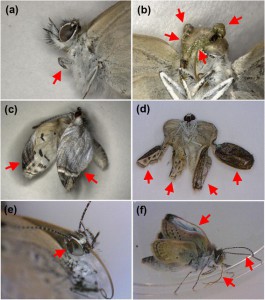Body size evolution in sloths • Parents’ experiences of neonatal intensive care units • Dental caries and the sugar intake goal • Ocean acidification and the great spider crab • Acetylcholinesterase against gastric cancer • Peer review

Evolutionary biology: Body size evolution in sloths.
The two living genera of sloths are both small-bodied and arboreal despite diverging approximately 30 million years ago. Using the data of 57 species of both living and fossil sloths, changes in body mass means and variance through evolution were examined. The evolution of sloth body size was shown to be complex and dominated by trended walks towards the large sizes of recently extinct forms. Researchers thereby demonstrated the importance in integration of fossil record data in reconstructing character evolution. A blog entry on this article is available here.
Pediatrics: Parents’ experiences of neonatal intensive care units.
Family-centred care within neonatal intensive care units involves the active consideration of parents’ experiences of having a premature baby by the healthcare professionals involved. In-depth interviews with parents of babies born before 32 weeks highlighted three domains, key factors in determining their experiences with NICUs following very premature birth; parents involvement in looking after their premature baby, staff competence and efficiency, and interpersonal relationships with staff. These findings support previous studies and can be used to further enhance and improve family-centred care in this context.
Global Health: Dental caries and the sugar intake goal.
Dental caries is the most common chronic disease in industrial and lower income countries and whilst the prevalence and severity of dental caries have diminished in the past two decades it is still remains an important and largely preventable public health problem. The WHO goal for sugar intake stands at 10% of energy intake (10%E). Analyses of caries incidence for countries where sugar intake was altered due to wartime restrictions or nutritional transition show results that call for a change in this goal. The robust log-linear relationship of caries to sugar intake from 0%E to 10%E has led researchers to suggest a new pragmatic goal of <5%E for sugar intake.
Image of the month

Morphological abnormalities of butterflies fed on radioactively contaminated diets. From “Ingestion of radioactively contaminated diets for two generations in the pale grass blue butterfly.” Nohara et al. BMC Evolutionary Biology 2014, 14:193 Click here for a blog entry on this topic.
Genomics: Ocean acidification and the great spider crab.
Carbon dioxide-induced ocean warming and acidification may have adverse effects on marine organisms. Once such organism is the giant spider crab, a slow-moving and inactive species, ideal for studying the medium to long-term effects of abiotic stressors. Researchers have used global gene expression profiling to study transcriptional responses in the gills of crabs exposed to increased carbon dioxide levels at different temperatures. Responses to increasing water carbon dioxide concentrations were shown to be non-linear with intermediate ocean acidification levels seeing an increase in expression of stress-related genes, an effect which is attenuated at higher levels.
Cancer : Acetylcholinesterase against gastric cancer.
Gastric cancer is one of the leading causes of cancer-related deaths worldwide and whilst the importance of acetylcholinesterase (AchE) expression has been implicated in recent research, there is a paucity of work on cancer therapy using viral vectors to deliver this hydrolase. An oncolytic adenovirus was constructed to express AchE which was then shown to both inhibit gastric cancer cell growth, suppress the growth of gastric cancer stem cells, and repress tumor growth in vivo.
Peer review: Which system for you?
To mark the second anniversary of BMC Pharmacology and Toxicology we conducted a short survey of our Editorial Board to receive feedback on peer review. The results of this survey published in BMC Pharmacology and Toxicology, reveal that the majority of Editorial Board Members prefer double-blind peer review – where authors and reviewers do not know each other’s identity – over open peer review, the system that the journal operates. However, of those Editorial Board Members that favoured open peer review, they did so because it increased accountability and transparency. Certainly, we agree with those sentiments and feel that the potential benefits of openness outweigh the negatives. For further discussion on this topic visit the BMC blog.
![]() Follow @BMC_series
Follow @BMC_series
![]() Watch our YouTube channel
Watch our YouTube channel
![]() Browse our list of journals
Browse our list of journals
![]() Subscribe to updates from the blog
Subscribe to updates from the blog
Comments